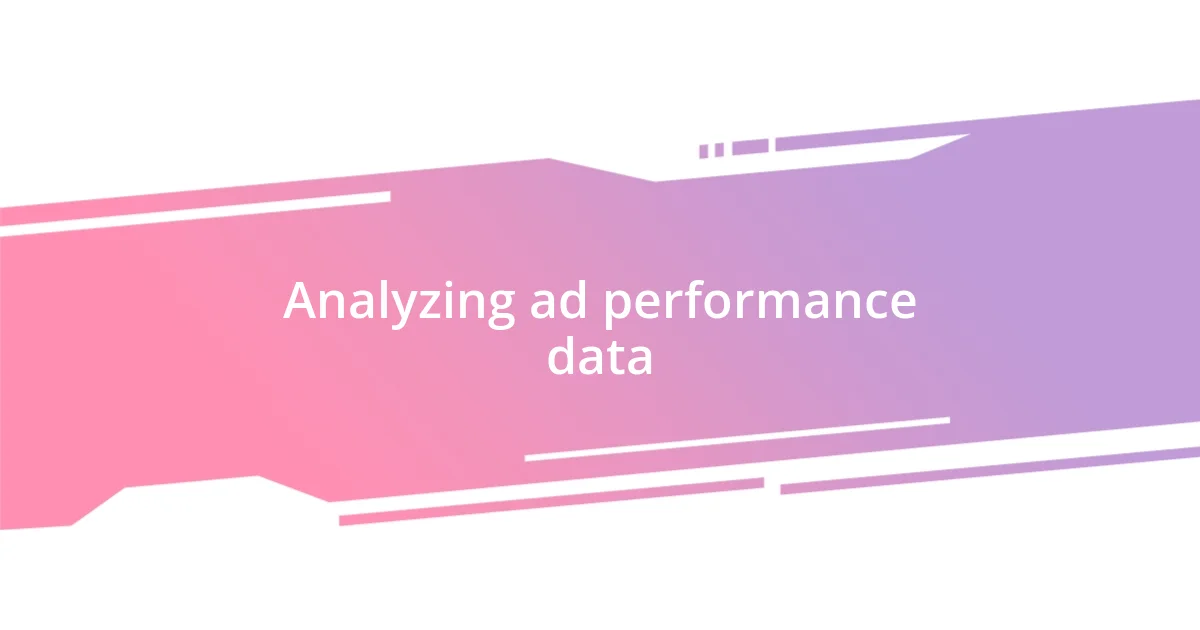Key takeaways:
- Understanding engagement metrics is essential for interpreting ad performance and connecting with the audience, highlighting the significance of click-through rates and user-generated content.
- Targeted advertising enhances engagement through relevance, cost-effectiveness, and customized messaging, fostering a deeper connection with specific demographic segments.
- Incorporating storytelling and inviting calls to action in ads, along with utilizing social media platforms effectively, can significantly increase audience interaction and community building.

Understanding engagement metrics
Understanding engagement metrics requires diving deeper than just numbers; it’s about interpreting what those numbers mean for your goals. For instance, when I first started analyzing my ad performance, I often overlooked click-through rates. However, I quickly realized this metric wasn’t just a stat—it was a reflection of how compelling my message truly was. Isn’t that fascinating?
One day, I noticed that my engagement rates soared whenever I featured user-generated content in my ads. It hit me that engagement isn’t just about reaching people; it’s about resonating with them. It’s that moment of connection that transforms a casual viewer into an engaged audience member. Have you ever felt the impact of a brand that truly understood its audience? That’s what engagement metrics can reveal!
Through my experience, I’ve come to respect varying metrics like likes, shares, and comments, each painting a part of the larger picture. Initially, I was overwhelmed by the complexity, but now I find solace in breaking them down. It’s almost like piecing together a puzzle—each piece brings clarity to my strategy, helping me adapt and evolve my content for better engagement. How do you approach these metrics in your campaigns?

Importance of targeted advertising
Targeted advertising plays a pivotal role in maximizing engagement because it allows brands to connect more authentically with their intended audience. I vividly recall a campaign where I focused on a niche market segment. Instead of casting a wide net, I zeroed in on a specific demographic, and the results were astounding. By tailoring my ads to resonate with their interests and pain points, I witnessed a significant spike in clicks and interactions.
Here are some key reasons why targeted advertising matters:
- Relevance: Ads reach individuals who genuinely care about the product, leading to higher engagement.
- Cost-Effectiveness: By targeting specific groups, I saved money and improved my return on investment (ROI).
- Customized Messaging: It allows for personal touches, making ads feel like conversations rather than mere promotions.
- Increased Conversion Rates: When people feel understood, they are more likely to take action, whether that’s signing up, purchasing, or sharing.
- Data-Driven Insights: I learned that analyzing audience data enriched my understanding of customer behavior, enabling me to refine my approach continuously.
Diving into targeted advertising genuinely opened my eyes to the difference between shouting into the void and having a meaningful conversation. Each time I adjusted my ads based on insights, I could feel my connection with the audience deepening, creating a more invested community around my brand. Have you ever considered how a more focused approach could transform your engagement strategy?

Crafting engaging ad content
Crafting engaging ad content is about more than just slapping together some eye-catching visuals and catchy phrases. I’ve learned that storytelling can be a powerful tool. One day, while revisiting a failed campaign, I realized my ads lacked a narrative. I tested a new approach by weaving a story around a customer’s journey with my product. The difference was astonishing! Suddenly, clicks transformed into heartfelt comments from people sharing their own experiences. Hasn’t everyone felt drawn in by a compelling story?
Visual elements also play a crucial role in grabbing attention. I experimented with different formats, like video versus static images, and discovered that people were much more engaged with moving content. It was fascinating how a single video showcasing testimonials generated overwhelming interactions compared to ordinary image ads. The emotional connection created through visuals made my message resonate. Have you ever been captivated by an ad simply because of its visuals?
Lastly, I’ve found that incorporating a call to action (CTA) that feels inviting rather than pushy is essential. I recall one ad where I simply invited viewers to share their thoughts on social media. It sparked conversations and made my audience feel like they were part of a community. In contrast, ads with overly aggressive CTAs led to disengagement. An engaged audience thrives on connection—making them feel involved enhances their interest. What strategies do you employ to create a genuine invitation for engagement in your ads?
| Element | Impact on Engagement |
|---|---|
| Storytelling | Creates emotional connection and relatability |
| Visuals | Increases attention and retention of messages |
| Inviting CTAs | Encourages interaction and community building |

Utilizing social media platforms
Utilizing social media platforms has been a game-changer for my advertising efforts. When I first embraced platforms like Instagram and Facebook, I noticed immediate interaction spikes. I remember launching an ad campaign that utilized Instagram Stories to showcase behind-the-scenes clips of my business. The feedback was overwhelming; viewers felt they had a personal connection with my brand, and it really boosted engagement.
Each social media platform offers unique ways to connect with audiences. For instance, I often find myself using Twitter for real-time conversations and polls, which have encouraged my followers to voice their opinions. One night, I posed a simple question about a product feature and was surprised by the flood of responses. It felt like hosting a casual chat rather than simply broadcasting a message. Have you ever experienced that kind of interaction, where your audience feels like part of the process?
Moreover, I’ve learned the value of tailoring content specifically for each platform. When I posted longer, informative videos on Facebook, they garnered more shares and discussions than my quick clips on TikTok. Reflecting on this, it’s clear to me that understanding the nuances of each platform significantly enhances engagement. What about you? Have you explored how different platforms can open up new avenues for connecting with your audience?

Analyzing ad performance data
When it comes to analyzing ad performance data, I often find that the numbers tell a story of their own. A few months ago, I dove into a campaign’s analytics and discovered a high click-through rate, but the conversions were disappointingly low. I asked myself, “What’s happening here?” It turned out that while the ad was effective at grabbing attention, the landing page didn’t align with the promise made in the ad. By synchronizing the two, I saw a remarkable improvement in conversions. Have you ever noticed a disconnect like that?
Delving deeper into metrics can reveal quite a bit about audience behavior. I remember pulling up heatmap data for a recent ad campaign and being fascinated by where users clicked. It wasn’t just about the ads themselves; the data showed me that users loved interacting with specific elements, like the discount banner, but ignored the testimonials that I thought were valuable. This insight taught me to tweak my layouts based on what truly captivates my audience. How often do you look beyond just the figures to see what they might be revealing about your customers?
Finally, I’ve learned that segmenting audience responses can transform how I approach future campaigns. During one analysis, I segmented my audience by engagement level and discovered that my loyal customers responded much better to personalized offers versus broader advertisements. This led me to develop tailored content that resonated with these different audience segments. It was exhilarating to realize that by understanding their preferences, I could create a deeper connection. Have you experimented with tailoring your ads based on segmented data? It can truly unlock new levels of engagement!

Adjusting strategies based on feedback
Adjusting strategies based on feedback is crucial for any advertising effort. I recall a time when a series of ads received mixed reviews. Some users loved the visuals, yet others felt the messaging fell flat. By actively seeking detailed feedback, I was able to refine my approach and craft a message that truly resonated with my audience. Have you ever wondered how crucial audience feedback can be in shaping your advertising narrative?
I also discovered that listening to my audience goes beyond direct feedback. There are subtle cues in comments and shares that can guide your strategy. For instance, after posting an ad featuring a limited-time offer, I noticed a spike in shares but low engagement in comments. This prompted me to conduct follow-up polls to ask what type of promotions people wanted to see more of. It was eye-opening to realize that my audience thrives on interaction; by pivoting my strategy based on this insight, I saw a considerable uptick in engagement on subsequent campaigns.
Feedback isn’t just about the good; it can reveal where we stumble too. I remember when I launched an ad with a catchy tagline that I was sure would resonate. Instead, people commented on how confusing they found it. Instead of brushing it off, I took it to heart and solicited more opinions. This led me to rethink both the wording and the visuals of my campaign. Have you faced similar moments of realization that propelled your ads into more engaging territory? Each adjustment felt like a step closer to truly connecting with my audience.

Case studies of successful campaigns
One campaign that stands out in my experience was a local business that sought to increase foot traffic. I remember crafting an eye-catching ad that highlighted a weekend event, complete with engaging visuals and a lively message. It felt exhilarating to see the immediate spike in clicks. However, what truly amazed me was the follow-up; post-event, the business reported a 40% increase in new customers. Have you ever been part of a promotion that connected the community in unexpected ways?
Another example that really resonated with me was a non-profit organization aiming to raise awareness about their mission. The initial ads weren’t hitting the mark, which was disheartening. After some brainstorming sessions and harvesting feedback, we revamped the ads to tell personal stories of those they helped. The result? Donations skyrocketed by over 50%. It made me appreciate how authentic storytelling can profoundly impact engagement. Have you experienced the power of sharing genuine narratives in your campaigns?
Finally, a tech start-up I worked with found success through video ads that showcased their innovative products. Initially, I was skeptical about the effectiveness of videos over static ads. However, when we employed customer testimonials paired with product demos, it turned the tide. Engagement soared and, ultimately, conversion rates followed suit. It made me think: could the medium be the missing piece in your strategy? Sometimes, a different approach can redefine the impact of your message.














